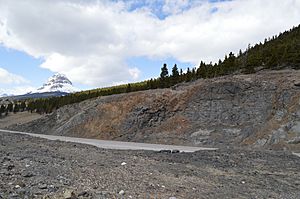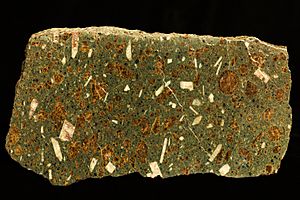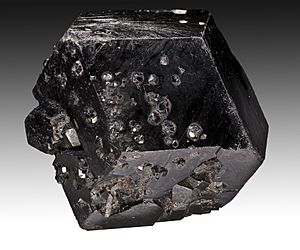Crowsnest Formation facts for kids
Quick facts for kids Crowsnest FormationStratigraphic range: Mid to Upper Albian |
|
|---|---|

The west end of the type section of the Crowsnest Formation, on the Crowsnest Highway west of Coleman, Alberta.
|
|
| Type | Geological formation |
| Unit of | Blairmore Group |
| Underlies | Blackstone Formation |
| Overlies | Ma Butte Formation |
| Thickness | Up to 488 metres (1,600 ft) |
| Lithology | |
| Primary | Volcanic rocks, pyroclastic breccia |
| Other | Sandstone |
| Location | |
| Coordinates | 49°38′51″N 114°31′48″W / 49.64750°N 114.53000°W |
| Region | |
| Country | |
| Extent | Western Canadian Sedimentary Basin |
| Type section | |
| Named for | Crowsnest Pass |
| Named by | G.M. Dawson |
The Crowsnest Formation, also known as the Crowsnest Volcanics, is a special layer of rock found in southwestern Alberta, Canada. It's part of a larger area called the Western Canadian Sedimentary Basin. This rock layer got its name from the nearby Crowsnest Pass near Coleman, Alberta.
Most of the Crowsnest Formation is made of rocks formed from ancient explosive eruptions. These eruptions happened about 100 million years ago, during a time called the Early Cretaceous period. What makes these rocks extra cool are the unusual minerals they contain, like melanite (a type of garnet) and analcime (a type of zeolite).
Contents
What are Crowsnest Volcanics Made Of?

The Crowsnest Formation contains many types of volcanic rocks. These include rocks formed from fast-moving flows of hot ash and gas (called pyroclastic flows). There are also lahars, which are like volcanic mudslides. Other rocks include agglomerates and tuffs, which are made of volcanic ash.
You can also find sandstones here that are rich in volcanic material. While the overall chemistry of these volcanic rocks is common, their minerals are quite special. Besides analcime and melanite, you can find minerals like sanidine, aegerine-augite, and chlorite.
One very rare rock, called Blairmorite, is found only here and in one place in Mozambique. It's named after the town of Blairmore, Alberta. Blairmorite is special because it contains a lot of the mineral analcime.
How Old is the Crowsnest Formation?
The Crowsnest Formation is the top layer of a group of rocks called the Blairmore Group. You can see great examples of these rocks along the Crowsnest Highway (Highway 3) and the railroad west of Coleman. This area is known as the "type locality," meaning it's where the rocks were first studied and described.
Below the Crowsnest Formation is another rock layer called the Ma Butte Formation. As you go from the Ma Butte Formation upwards into the Crowsnest Formation, you start to see more and more volcanic pieces.
The lower parts of the Crowsnest Formation have minerals like sanidine, melanite, and pyroxene. The upper parts also contain sanidine, analcime, melanite, and pieces of other rocks. On top of the Crowsnest Formation, you'll find shale rocks from the Blackstone Formation. These shales were laid down when the sea covered the land during the Late Cretaceous period.
Where Did These Volcanic Rocks Come From?
The volcanic rocks of the Crowsnest Formation were laid down on a flat area, like a floodplain. This floodplain is represented by the older Ma Butte Formation rocks beneath them. Scientists believe the volcanic eruptions likely happened to the west, near where Cranbrook, British Columbia, is today.
Over millions of years, these rocks were pushed eastward by huge forces in the Earth's crust. This process, called thrust faulting, happened during a mountain-building event known as the Laramide orogeny.
It's thought that these volcanic rocks originally covered an area of about 1,800 km2 (690 sq mi). The total amount of volcanic material is estimated to be around 209 km3 (50 cu mi). That's a lot of volcanic rock!
Where Can You Find the Crowsnest Volcanics Today?
The Crowsnest Volcanics can be seen in the Front Ranges and foothills of the southern Canadian Rockies. They are found in layers that are folded and tilted.
These rock layers are thickest along a line that goes north from Coleman. In some places, they can be as thick as 426 to 488 metres (1,400 to 1,600 ft). This thickest area extends along McGillivray Ridge to Ma Butte.
Images for kids







